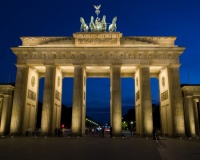Difference between revisions of "Brandenburg Gate (1788)"
(Created page with "200px|thumbnail|left === The 18th century triumphal arch in Berlin === The Brandenburg Gate is one of the most renowned landmarks in Germany, s...") |
|||
| Line 1: | Line 1: | ||
[[File:Brandenburg Gate.jpg|200px|thumbnail|left]] | [[File:Brandenburg Gate.jpg|200px|thumbnail|left]] | ||
| − | === | + | The Brandenburg Gate is one of the best known symbols of Berlin and Germany. The monument is situated on the Straße des 17. Juni, that cuts through the big Tiergarten in Berlin. Nearby are the Reichstag and the Holocaust Monument, both very prominent symbols of the city as well. |
| + | |||
| + | |||
| + | ===Historical Background=== | ||
| + | During the 18th century, Prussia was allied to England and the Dutch Republic. In 1782 however, the rebellion in the Republic against Stadtholder William V threatened the friendly relations. Important in this matter too, was the wife of William V, Wilhelmina of Prussia. She was the sister of the King of Prussia, Frederick William II. When she was caught by the patriotic rebellion, her brother did not hesitate to invade the Republic. In 1787 the patriots were chased away to France. | ||
| + | |||
| + | To commemorate the reaffirmed alliance between Great Britain | ||
| + | |||
| + | |||
| + | Symbol in the Third Reich | ||
| + | Symbol in the Cold War | ||
| + | Symbol nowadays | ||
| − | |||
[[Category: Monuments and Sculptures as Cultural Diplomacy]] | [[Category: Monuments and Sculptures as Cultural Diplomacy]] | ||
Revision as of 09:16, 9 January 2015
The Brandenburg Gate is one of the best known symbols of Berlin and Germany. The monument is situated on the Straße des 17. Juni, that cuts through the big Tiergarten in Berlin. Nearby are the Reichstag and the Holocaust Monument, both very prominent symbols of the city as well.
Historical Background
During the 18th century, Prussia was allied to England and the Dutch Republic. In 1782 however, the rebellion in the Republic against Stadtholder William V threatened the friendly relations. Important in this matter too, was the wife of William V, Wilhelmina of Prussia. She was the sister of the King of Prussia, Frederick William II. When she was caught by the patriotic rebellion, her brother did not hesitate to invade the Republic. In 1787 the patriots were chased away to France.
To commemorate the reaffirmed alliance between Great Britain
Symbol in the Third Reich
Symbol in the Cold War
Symbol nowadays
